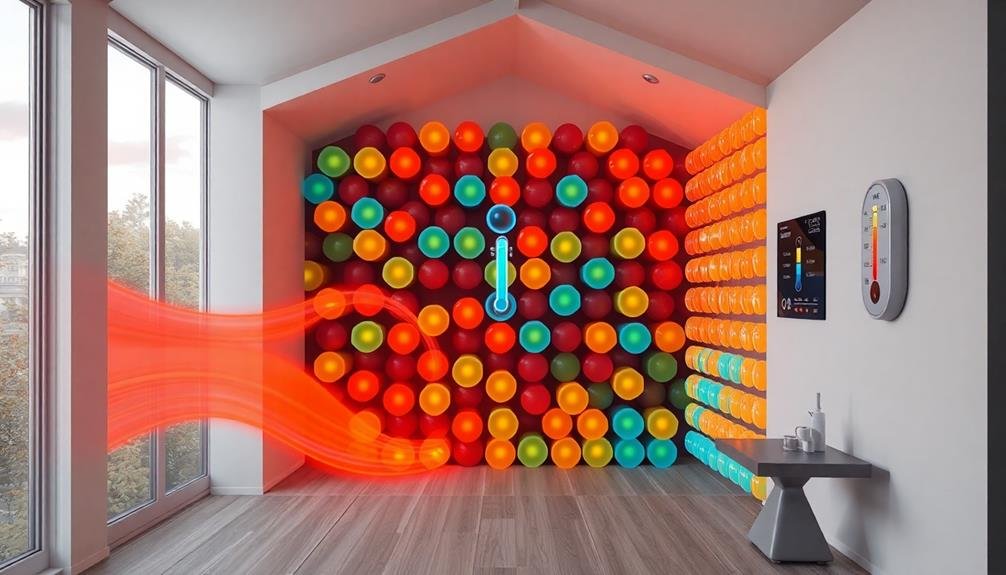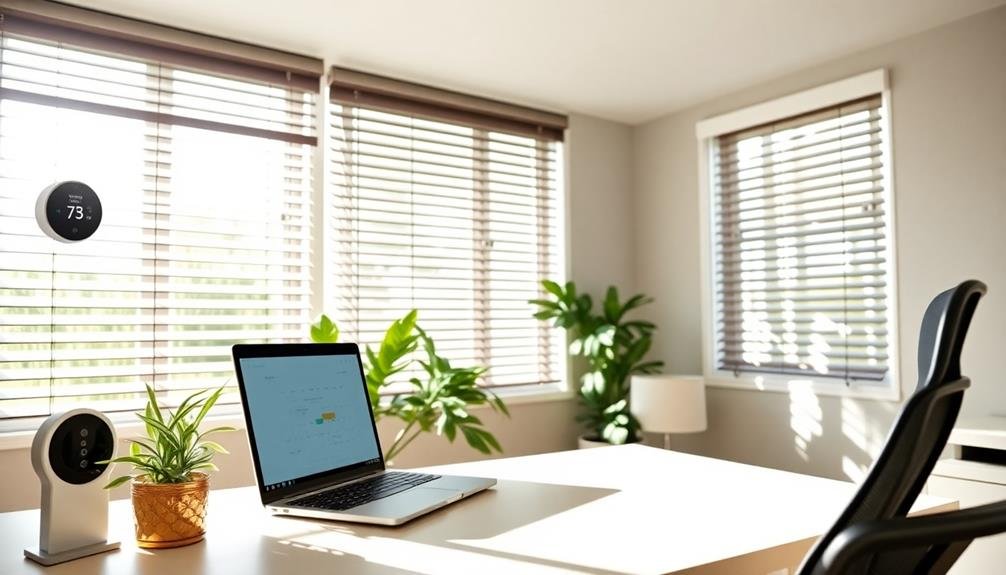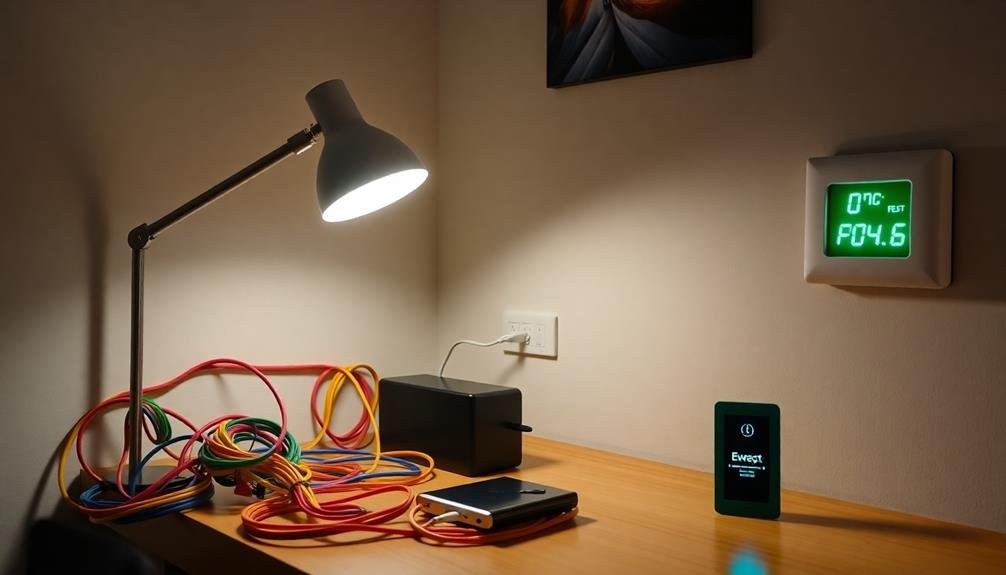Seven key phase change materials for home temperature control are paraffin wax, salt hydrates, fatty acids, bio-based PCMs, eutectic solutions, microencapsulated PCMs, and shape-stabilized PCMs. These innovative materials can absorb and release heat as they change phases, helping maintain comfortable indoor temperatures. Paraffin wax and salt hydrates are popular choices, while fatty acids offer excellent thermal storage. Bio-based PCMs provide an eco-friendly alternative, and eutectic solutions allow for precise temperature control. Microencapsulated and shape-stabilized PCMs offer improved stability and integration options. By exploring these materials, you'll discover how they can revolutionize your home's energy efficiency and comfort.
Paraffin Wax

Paraffin wax stands out as a popular phase change material for home temperature control. This versatile substance has a melting point between 20°C and 35°C, making it ideal for maintaining comfortable indoor temperatures. As it absorbs heat, paraffin wax shifts from solid to liquid, effectively storing thermal energy. When the surrounding temperature drops, it solidifies, releasing the stored heat.
You'll find paraffin wax incorporated into various home applications. It's often encapsulated in small containers or pouches and integrated into building materials like drywall or insulation. Some manufacturers even produce paraffin-infused fabrics for bedding and clothing. The material's high latent heat of fusion allows it to absorb and release significant amounts of energy during phase changes.
One of paraffin wax's main advantages is its cost-effectiveness and availability. It's non-corrosive, chemically inert, and has a long lifespan with proper containment.
However, it's essential to recognize that paraffin wax is flammable and derived from petroleum, which may concern environmentally conscious consumers. Despite these drawbacks, its efficiency in temperature regulation makes it a valuable tool in reducing energy consumption and improving home comfort.
Salt Hydrates
Salt hydrates offer another option for latent heat storage in home temperature control.
You'll find these materials have a melting point range typically between 20°C and 40°C, making them suitable for maintaining comfortable indoor temperatures.
When salt hydrates change phase, they can absorb or release large amounts of heat, effectively regulating your home's temperature without significant temperature fluctuations.
Latent Heat Storage
A hidden champion in the world of thermal energy storage, salt hydrates offer impressive latent heat storage capabilities. When you're looking to regulate your home's temperature efficiently, these materials can be a game-changer.
Salt hydrates absorb and release large amounts of energy during phase changes, making them ideal for latent heat storage applications. You'll find that salt hydrates can store 5-14 times more heat per unit volume than sensible heat storage materials like water or rock.
This high energy density means you can use smaller storage systems, saving valuable space in your home. When the temperature rises, salt hydrates melt, absorbing excess heat. As it cools, they solidify, releasing stored heat back into your living space.
While salt hydrates are cost-effective and non-flammable, you should be aware of their tendency to separate and supercool. To overcome these issues, you can use nucleating agents and thickeners.
Some common salt hydrates you might encounter include calcium chloride hexahydrate and sodium sulfate decahydrate. By incorporating these materials into your home's thermal management system, you'll enjoy more stable temperatures and reduced energy costs.
Melting Point Range
When selecting salt hydrates for your home temperature control system, understanding their melting point range is crucial. Salt hydrates offer a wide range of melting points, typically between 20°C and 40°C, making them suitable for various climate control applications. You'll want to choose a salt hydrate with a melting point close to your desired room temperature for ideal performance.
Here's a table of common salt hydrates and their melting points:
| Salt Hydrate | Melting Point (°C) | Heat of Fusion (kJ/kg) |
|---|---|---|
| CaCl2·6H2O | 29 | 190 |
| Na2SO4·10H2O | 32 | 254 |
| Na2HPO4·12H2O | 35 | 280 |
Remember that salt hydrates can experience supercooling, where they remain liquid below their melting point. This can affect their performance in your system. To mitigate this, you can add nucleating agents or use a salt hydrate mixture. It's also important to take into account the salt hydrate's stability over multiple freeze-thaw cycles, as some may degrade or separate over time. By carefully selecting the right salt hydrate with an appropriate melting point range, you'll guarantee efficient and effective temperature control in your home.
Fatty Acids

You'll find fatty acids to be another promising category of phase change materials for home temperature control.
These organic compounds offer excellent thermal storage properties, with the ability to absorb and release large amounts of latent heat during their phase shifts.
Fatty acids typically have melting point ranges between 16°C and 65°C, making them suitable for various heating and cooling applications in residential settings.
Thermal Storage Properties
While many phase change materials exist, fatty acids stand out for their impressive thermal storage properties. When you're considering fatty acids for home temperature control, you'll find they can store and release large amounts of heat during phase shifts. This makes them excellent candidates for thermal energy storage systems.
Fatty acids typically have high latent heat values, allowing them to absorb or release significant amounts of energy without changing temperature. You'll notice they've melting points in the range of 16-65°C, which is ideal for residential applications. These materials can effectively stabilize indoor temperatures, reducing the need for constant heating or cooling.
You'll appreciate that fatty acids have good thermal conductivity, ensuring efficient heat transfer. They're also chemically stable, maintaining their properties over numerous freeze-thaw cycles. This longevity makes them cost-effective for long-term use. Additionally, fatty acids are non-toxic and biodegradable, addressing safety and environmental concerns.
When selecting fatty acids for your home, consider their specific melting points and latent heat capacities. These properties will determine how effectively they'll regulate your indoor temperature throughout the year.
Melting Point Ranges
Fatty acids used in phase change materials exhibit a wide range of melting points, typically falling between 16°C and 65°C. This broad spectrum allows you to select the most appropriate fatty acid for your specific temperature control needs. For instance, if you're aiming to maintain a comfortable room temperature around 20-22°C, you'd choose a fatty acid with a melting point in that range.
Common fatty acids used in PCMs include capric acid (melting point: 32°C), lauric acid (44°C), and stearic acid (69°C). You'll find that even small changes in the fatty acid's molecular structure can greatly affect its melting point. By blending different fatty acids, you can fine-tune the melting point to match your desired temperature range.
It's important to note that the melting process occurs over a narrow temperature range rather than at a single, precise temperature. This characteristic allows for gradual heat absorption and release, providing a more stable and consistent temperature control in your home.
When selecting a fatty acid PCM, you'll need to take into account not only the peak melting point but also the entire phase shift range to guarantee the best performance in your specific application.
Bio-based PCMs
Bio-based PCMs offer an eco-friendly alternative to traditional phase change materials. These organic compounds, derived from renewable sources, can help you reduce your carbon footprint while maintaining comfortable indoor temperatures.
You'll find that bio-based PCMs often come from plant-based oils, fatty acids, and other natural substances.
When choosing bio-based PCMs for your home, consider these key advantages:
- Biodegradability: They break down naturally, minimizing environmental impact.
- Non-toxicity: They're safe for use in residential settings, posing no health risks.
- Renewable sourcing: They're made from sustainable materials, reducing reliance on fossil fuels.
- Compatibility: They work well with various building materials and HVAC systems.
You'll discover that bio-based PCMs can be just as effective as their synthetic counterparts in regulating temperature. They typically have melting points between 20°C and 35°C, making them ideal for home use.
While they may have a slightly lower latent heat storage capacity compared to some synthetic PCMs, their environmental benefits often outweigh this minor drawback.
As you explore options for temperature control in your home, don't overlook the potential of bio-based PCMs to provide a sustainable solution.
Eutectic Solutions

Another innovative option in the world of phase change materials is eutectic solutions. These are carefully engineered mixtures of two or more substances that have a lower melting point than their individual components.
You'll find that eutectic solutions offer precise temperature control and can be tailored to specific needs.
When you're looking at eutectic PCMs for home temperature control, you'll discover they often combine inorganic salts or organic compounds. These mixtures can absorb and release heat at a constant temperature, making them ideal for maintaining comfortable indoor environments.
You might encounter eutectic solutions that use combinations like calcium chloride hexahydrate and magnesium chloride hexahydrate, or sodium sulfate and sodium chloride.
One of the key advantages you'll notice with eutectic solutions is their ability to be fine-tuned. By adjusting the proportions of components, you can create PCMs with specific melting points to match your climate needs.
This flexibility allows for more efficient energy storage and release in your home's thermal management system. Additionally, you'll find that many eutectic solutions have higher energy storage densities compared to single-component PCMs, potentially reducing the volume of material needed for effective temperature control.
Microencapsulated PCMs
Microencapsulated PCMs represent a notable advancement in phase change material technology. These tiny capsules, typically ranging from 1 to 1000 micrometers in diameter, contain phase change materials within a protective shell. This encapsulation process offers several advantages over bulk PCMs, making them more versatile and easier to integrate into various building materials and textiles.
When you're considering microencapsulated PCMs for home temperature control, you'll find they offer numerous benefits:
- Improved thermal stability: The protective shell prevents leakage and reduces the risk of contamination.
- Enhanced heat transfer: Smaller particles increase the surface area for heat exchange, improving efficiency.
- Easy integration: You can mix them into paints, plasters, or fabrics without altering their physical properties.
- Longer lifespan: The shell protects the PCM from degradation, extending its useful life.
These innovative materials can be incorporated into walls, ceilings, and even furniture to help regulate indoor temperatures. By absorbing excess heat during the day and releasing it at night, microencapsulated PCMs can notably reduce your home's energy consumption and improve overall comfort.
They're particularly effective in climates with large daily temperature fluctuations, helping to maintain a more consistent indoor environment throughout the day.
Shape-stabilized PCMs

Shape-stabilized PCMs have emerged as a significant advancement in phase change material technology. These innovative materials combine PCMs with a supporting structure, typically a polymer matrix, to create a stable composite that maintains its shape during phase changes.
Unlike traditional PCMs, shape-stabilized PCMs don't require separate containment, making them easier to integrate into building materials and applications.
You'll find that shape-stabilized PCMs offer several advantages. They've improved thermal conductivity, which enhances heat transfer efficiency. They're also less prone to leakage and have better long-term stability.
Manufacturers can produce these PCMs in various forms, such as sheets, panels, or even as part of construction materials like wallboards or insulation.
When you're considering shape-stabilized PCMs for home temperature control, you'll appreciate their versatility. You can incorporate them into walls, ceilings, or floors to passively regulate indoor temperatures.
They're particularly effective in reducing peak cooling loads and improving overall thermal comfort. As research continues, you can expect to see more innovative applications of shape-stabilized PCMs in sustainable building design and energy-efficient home solutions.
Frequently Asked Questions
How Do Phase Change Materials Compare to Traditional HVAC Systems in Energy Efficiency?
You'll find phase change materials can be more energy-efficient than traditional HVAC systems. They store and release heat passively, reducing the need for constant energy input. However, their effectiveness depends on climate and building design.
Can PCMS Be Retrofitted Into Existing Homes, or Only New Construction?
You can retrofit PCMs into existing homes. They're often installed in walls, ceilings, or floors. However, it's easier to incorporate them during new construction. For retrofits, you'll need to contemplate space constraints and installation methods carefully.
What Is the Typical Lifespan of PCMS Used for Home Temperature Control?
You'll find that PCMs used for home temperature control typically last 20-30 years. They don't degrade easily, but their effectiveness can diminish over time. You should check with manufacturers for specific lifespan estimates of their products.
Are There Any Health or Safety Concerns Associated With Using PCMS?
You shouldn't worry too much about PCM safety. They're generally non-toxic and safe for home use. However, you'll want to guarantee proper encapsulation to prevent leaks and follow manufacturer guidelines for installation and maintenance.
How Do PCMS Affect Indoor Air Quality and Humidity Levels?
PCMs don't directly impact air quality or humidity, but they can help stabilize indoor temperatures. This may indirectly reduce moisture issues. You'll still need proper ventilation and humidity control for ideal indoor air quality.
In Summary
You've now explored seven innovative phase change materials for home temperature control. From common paraffin wax to cutting-edge microencapsulated PCMs, you've got a range of options to evaluate. Whether you're looking for natural solutions like bio-based PCMs or more engineered approaches like shape-stabilized PCMs, there's something to suit your needs. By incorporating these materials into your home, you'll be able to maintain a comfortable temperature while potentially reducing your energy consumption and costs.





Leave a Reply